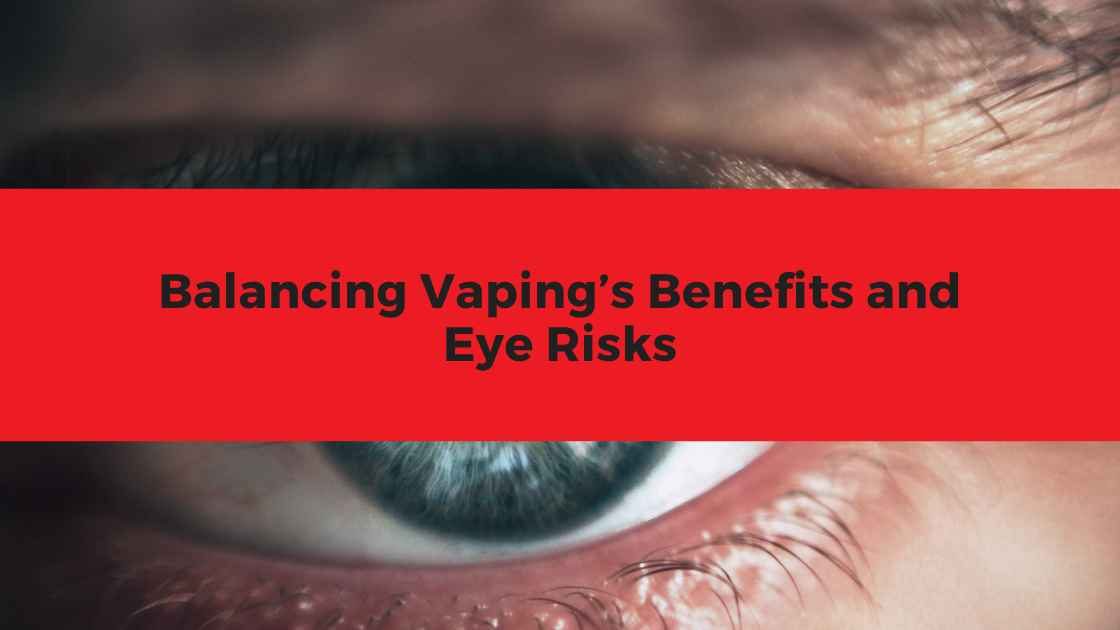In the UK, health authorities like the NHS and Public Health England have long endorsed vaping as a significantly safer alternative to smoking traditional cigarettes. According to a 2014 analysis led by Professor David Nutt, e-cigarettes pose only a small fraction of the harm caused by combustible tobacco, making them a valuable tool for harm reduction among smokers [1]. This consensus underscores vaping’s role in reducing the devastating effects of smoking, such as lung cancer and heart disease, by eliminating tar and carbon monoxide—two of tobacco’s most dangerous components. However, vaping is not without risks. This article examines the evidence and limitations of recent studies into vaping and eye conditions.
Emerging Concerns: Vaping and Eye Health
While vaping sidesteps many of smoking’s harms, recent research suggests cause for concern regarding eye health. A notable study, analysing data from over 800,000 individuals, found that e-cigarette users are 2.53 times more likely to develop uveitis—an inflammatory eye condition—than non-users [2]. Uveitis can cause blurred vision, pain, and light sensitivity, and in severe cases, it may lead to vision loss. This finding stands out against vaping’s safer-than-smoking reputation, prompting a closer look at whether this risk undermines its harm-reduction benefits.
For context, smoking itself is a well-known risk factor for eye diseases like cataracts and age-related macular degeneration, driven by oxidative stress and toxic exposure from smoke. Vaping, by contrast, avoids combustion, so its potential link to uveitis likely stems from different mechanisms—perhaps the chemicals in e-liquids or vapour. While this risk is concerning, it’s critical to weigh it against smoking’s broader and more severe impact on vision and overall health. The question becomes: does this eye-specific risk shift vaping’s safety narrative, or is it a minor caveat in an otherwise favourable comparison?
Unpacking the Evidence: Strengths and Gaps
The uveitis study offers compelling data, with its large sample size and consistent findings across age groups over four years. However, it’s not without flaws. The research relied on anonymous patient records, which limits insight into confounding factors like diet, genetics, or concurrent smoking [2]. Additionally, long-term data is scarce. Unlike smoking, where decades of evidence link it to chronic eye damage, vaping’s effects over time remain unclear due to its relatively recent rise.
Animal studies add another layer, showing that e-cigarette vapor can inflame retinal tissue in mice [3]. Yet, these experiments don’t perfectly mirror human vaping habits, as they involve whole-body exposure rather than inhalation alone. A review of vaping’s impact on the ocular surface also found short-term irritation but noted the absence of robust, long-term human studies [4]. Compared to smoking—where the evidence of harm is ironclad—these findings on vaping are preliminary, suggesting a need for caution rather than alarm.
Balancing Act: Eye Risk vs. Smoking’s Toll
From the UK perspective, vaping’s benefits as a smoking cessation tool remain robust. The 2.53-fold increased risk of uveitis, while significant, pales in comparison to smoking’s extensive damage—both to the eyes and beyond. Cigarette smoke directly exposes the eyes to toxins, increasing risks of multiple conditions, whereas vaping’s potential eye effects appear narrower and less severe. For smokers, switching to vaping still slashes overall harm, even if it introduces a specific, elevated risk like uveitis.
For non-smokers, however, the calculus differs. The NHS advise against taking up vaping, as any risk—however small—is unnecessary without the context of quitting smoking [1][5]. The eye health findings reinforce this stance, hinting that vaping’s safety edge is most meaningful when benchmarked against tobacco’s dangers, not as a standalone habit.
Moving Forward: Research and Awareness
The UK’s harm-reduction framework relies on evolving evidence, and vaping’s eye health implications highlight the need for more study. Long-term human trials could clarify whether uveitis and other conditions become widespread concerns among vapers, or if they’re outliers in an otherwise safe profile. Regulating e-liquid ingredients—some of which, like flavourings, may contribute to inflammation—could also mitigate risks while preserving vaping’s quitting potential [1].
For now, vapers might consider practical steps: monitoring for symptoms like eye redness or pain, opting for simpler e-liquids, and scheduling regular eye exams. These measures align with the UK’s proactive approach to vaping—maximising its benefits while addressing emerging questions.
Conclusion: A Safer Choice, But Not Risk-Free
The consensus from UK health bodies remains clear: vaping is a safer bet than smoking, offering a lifeline to millions looking to escape tobacco’s grip [1][5]. The finding that e-cigarette users face a 2.53 times higher risk of uveitis doesn’t unravel this narrative—it’s a wrinkle, not a rewrite [2]. Compared to smoking’s well-documented assault on vision and health, vaping’s risks appear limited and manageable. Still, these early signals call for vigilance, more research, and a nuanced view: vaping beats smoking hands down, but it’s not a blank check for perfect safety. For smokers, it’s a smart switch; for everyone else, it’s a risk worth skipping.
Sources
[1] UK Health Security Agency (2014): E-cigarettes and harm reduction. https://ukhsa.blog.gov.uk/2014/05/21/e-cigarettes-and-harm-reduction-where-are-we-now-and-what-next/
[2] ScienceDirect (2024): Risk of uveitis among E-Cigarette Users. https://www.sciencedirect.com/science/article/abs/pii/S0161642024007036
[3] PMC (2021): Retinal tissue develops an inflammatory reaction to tobacco smoke and electronic cigarette vapor in mice. https://www.ncbi.nlm.nih.gov/pmc/articles/PMC8455497/
[4] PubMed (2024): The Impact of Vaping on the Ocular Surface: A Systematic Review of the Literature. https://pubmed.ncbi.nlm.nih.gov/38731149/
[5] NHS: Vaping to quit smoking. https://www.nhs.uk/better-health/quit-smoking/vaping-to-quit-smoking/



Comments are closed here.